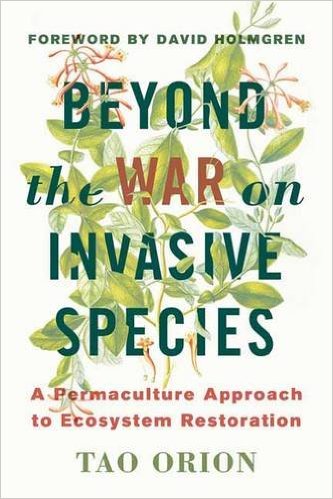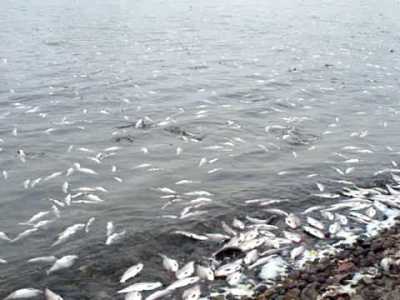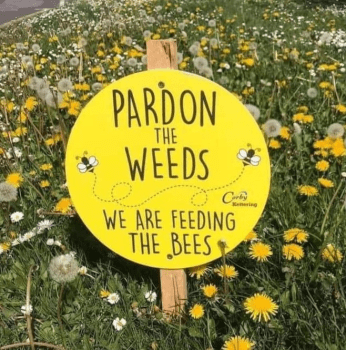Tao Orion is the author of Beyond the War on Invasive Species: A Permaculture Approach to Ecosystem Restoration, the latest in the rapidly growing literature about the futile and destructive attempts to eradicate non-native species. Ms. Orion will give a workshop at a PLACE for Sustainable Living on Thursday, September 17, 2015:
“Rethinking Invasive Species from a Permaculture Perspective”
Thursday, September 17, 2015, 6-8 pm
PLACE for Sustainable Living
1121 64th St, Oakland, CA 94608
Donations $12-$25 requested
Update: This is the answer PLACE for Sustainable Living gave to a question about wheelchair accessibility: “It is not wheel chair accessible yet – we have carried wheelchair persons up the steps with their wheelchairs – we can arrange for that. And the yard is filled with chipwood, wheel chairs have rolled over fine, but not sure if everyone in them can push through. Our friend, male, can push through fine.” Please contact PLACE for Sustainable Living directly if you have specific questions about accessibility. (addendum dated 9/10/15)
Update #2: Ms. Orion’s presentation has been cancelled because the venue is not wheelchair accessible. CUIDO (an organization which represents disabled people) asked that it be moved to a facility with wheelchair accessibility or cancelled. Such a facility could not be found, so it has been cancelled.
Update #3: Some adjustments have been made in plans for Ms. Orion’s presentation which are apparently acceptable to at least some members of the disabled community. Ms. Orion has therefore decided against cancelling it. Sorry for the confusion.
Ms. Orion is visiting the Bay Area from the Willamette Valley in Oregon, where she has a small farm in the country. She has a degree in agroecology and sustainable agriculture from UC Santa Cruz and she has studied at the Columbines School of Botanical Studies in Eugene, Oregon. She teaches permaculture design at Oregon State University and a non-profit sustainable-living educational organization. She has also worked as a permaculture designer for ecological restorations.
Beyond the War on Invasive Species
 The first chapter of Ms. Orion’s book is a breakthrough because it is an explicit indictment of pesticides used by so-called “restoration” projects. Although previously published books were critical of invasion biology and the ecological industry it spawned, pesticides were barely mentioned in them. In contrast, it is primarily the use of pesticides in ecological “restorations” that convinced Ms. Orion that the war on invasive species is doing more harm than good.
The first chapter of Ms. Orion’s book is a breakthrough because it is an explicit indictment of pesticides used by so-called “restoration” projects. Although previously published books were critical of invasion biology and the ecological industry it spawned, pesticides were barely mentioned in them. In contrast, it is primarily the use of pesticides in ecological “restorations” that convinced Ms. Orion that the war on invasive species is doing more harm than good.
Concern about unwanted plants – AKA weeds – is as old as human engagement in agriculture, that is, thousands of years old. And most of the plant and animal species now considered “invasive” were introduced by humans to serve a variety of purposes, including aesthetics, such as mute swans and multiflora roses. Some of these introduced plants and animals had unintended consequences such as competing with native plants and animals for available resources. Concern – even regret – about these introductions has increased greatly in the past 25 years. Attempts to manage these introductions has escalated from import limitations to fines and penalties and finally to attempts to eradicate plants and animals with pesticides.
The role of the pesticide industry in the escalating war on “invasive” species
Ms. Orion turns to the public record to make the case that the current focus on eradicating introduced species using pesticides was influenced by business interests. She points out that the federal Invasive Species Advisory Committee is a consortium of academic, professional, and business interests, including at least two people who are employed by manufacturers of pesticides. They make invasive species management policy recommendations to the National Invasive Species Council (NISC), created by Executive Order in 1999. The federal government is spending over $1 billion annually on research and control of “invasive” species, including pesticide applications.
The NISC is modeled after the California Exotic Pest Plant Council, created in 1992. That Council is now known as the California Invasive Plant Council (Cal-IPC). Cal-IPC brought together representatives from government agencies and non-profit environmental organizations, as well as manufacturers of pesticides and spray equipment: “Monsanto has sponsored Cal-IPC since its inception and both DuPont and Dow AgroSciences have also supported the group.” (1)
The first annual conference of Cal-IPC in 1993 featured an employee of Monsanto, Dr. Nelroy Jackson. Jackson’s presentation to Cal-IPC stated that “chemical weed control is the optimal method for control and removal of exotic plant species during…most native habitat restoration projects.”
Jackson’s involvement in escalating attempts to eradicate introduced species is troubling, but is not the only example of such collaboration between the “restoration” industry and the manufacturers of pesticides. The Weed Science Society, which advocates for “research, education, and awareness of weeds in managed and natural ecosystems,” has employees of Dow Agrosciences, Syngenta, and Dow Chemical on its board of directors. Those manufacturers of pesticides, as well as Monsanto, Bayer Crop Science, Dupont, and BASF Corp are also donors to the weed society, at the highest levels of donations.
The manufacturers of pesticides also influence the “restoration” industry by investing and participating in the consulting firms that write environmental impact reports for ecological “restoration” projects, such as Tetra Tech (which wrote the draft Environmental Impact Report for San Francisco’s so-called Natural Areas Program).
The manufacturers of pesticides influence public policy regarding ecological “restoration” by making large tax-deductible contributions to many land-grant universities that conduct research on agriculture: “A 2012 Report from Food and Water Watch found that nearly 25% of funding for agricultural research at public universities comes from private companies.” (1) This is one of many reasons why there is so little research done on non-chemical approaches to ecological restoration.
As disturbing as this collaboration between the government and the pesticide industry is, the evidence of the relationships between trusted non-profit environmental organizations and corporate interests is even more so. Nature Conservancy, National Audubon Society, and Ducks Unlimited all have close relationships with the manufacturers of pesticides and receive funding from them.
Ms. Orion then describes the use of pesticides by the “restoration” industry. She also describes some of the damage pesticides are known to do, such as killing microbes in the soil and binding minerals in the soil. She describes the persistence and mobility of pesticides in the environment. She describes the inadequacy of testing and regulation of pesticides in the United States. These issues are well known to the readers of Million Trees, so we won’t repeat them here, but new readers can click on the blue links to visit posts about those issues.
All introduced species are presumed to be harmful
Ms. Orion’s next chapters are more similar to the books that precede hers. There are several examples of specific “invasions” that illustrate the point that “invasive” species are usually symptoms of changes in the environment, rather than causes of those changes. Attempting to eradicate them does not reverse the changes in the environment and often causes more environmental damage. “Invasive” species are often performing valuable ecological functions that are not understood until they are eradicated. We have reported many examples of these issues and won’t repeat them here. However, Ms. Orion’s telling of the history of Asian Carp in the Mississippi River and the Great Lakes was new to us and is well worth a retelling.

Asian carp has been a mainstay in the diet of the Chinese for several thousand years, according to their historical literature. Asian carp are well adapted to aquaculture techniques, so they have the potential to replace or supplement other sources of protein. They were introduced to the Midwest in the early 1800s and they spread throughout the Mississippi River many decades ago. Although they are prevalent in the Mississippi River, they have not driven any native fish to extinction. Yet, despite their usefulness and the lack of evidence that they have caused any harm, they suddenly became the latest invasion crisis when it was feared they would soon enter the Great Lakes. A government fisheries biologist put that fear into perspective:
“We are trying to keep invasive Chinese carps out of the Great Lakes, to protect an invasive (yet purposefully stocked) Pacific salmon fishery, which was stocked as a management tool to control hyper-abundant alewifes, another invasive fish species, because the native piscivore, the Lake Trout, was nearly wiped out by another invasive species, the sea lamprey, because people built the Welland Canal around Niagara Falls to promote intercontinental shipping deep into the Great Lakes basin.” (1)
It makes the head spin to follow the “logic” of this sequence of events, which we paraphrase, “we solved one problem by creating another, then we solved that problem by creating another…ad infinitum.“ This is an ecosystem that has been radically altered by man, including reversing the flow of the Chicago River which connects the Mississippi River to the Great Lakes to solve Chicago’s sewage problems. The water is warmer, polluted with agricultural runoff, and there is no longer a seasonal, cleansing water surge. These changes in the environment set the stage for the arrival of Asian Carp in the Great Lakes. The habitat for native fish has been radically altered such that removal of Asian carp from the river is an irrelevant, inconsequential improvement of habitat needed by native fish.
Despite what would seem overwhelming evidence that Asian carp could be a valuable food source and that being rid of them is unlikely to benefit anyone, here is a brief list of what has been done so far to try to prevent them from entering the Great Lakes:

- US Army Corps of Engineers constructed a submerged electric fence to shock and kill the fish as they enter the Great Lakes. The fence cost millions of dollars but is largely ineffective.
- The Illinois Department of Natural Resources dumped 2,200 gallons of rotenone into sanitary and ship canals feeding into the Great Lakes. This poison kills all gilled animals. The result: “Among the tens of thousands of dead fish, researchers found one Asian carp.” (1) This fiasco cost $3 million.
- Other researchers have suggested a system of strobe lights and bubble and sound barriers to stop the northward migration of Asian carp.
Permaculture philosophy
Ms. Orion’s closing chapters reflect her training in permaculture design. She considers the tending of the wild by Native Americans a model for ideal stewardship of the land. And she advocates for land management strategies that reflect the realities of our changed environment and are sustainable into the future. We will let her speak for herself:
“Holistic restoration planning requires an honest accounting of what has come to pass as well as a comprehensive view of what we can do about it. The problems are complex, and the solutions are likely to be more so…Navigating from a paradigm that views invasive species as scourges to one that looks at them as opportunities for deeper ecological and economic engagement will take time and commitment, especially because the old paradigm is so entrenched politically, economically, and academically. The tide is shifting though, as more and more of us are coming to realize that the herbicide-based eradication approach to restoration is outmoded—a futile attempt to regain an imagined past—and we need to be focusing our time, resources, and energy on adapting to the future.” (1)
Please show your support for Tao Orion and her book by attending her workshop on Thursday, September 17th.
(1) Tao Orion, Beyond the War on Invasive Species: A Permaculture Approach to Ecosystem Restoration, Chelsea Green Publishing, 2015


Wonderful. Thank you so much!